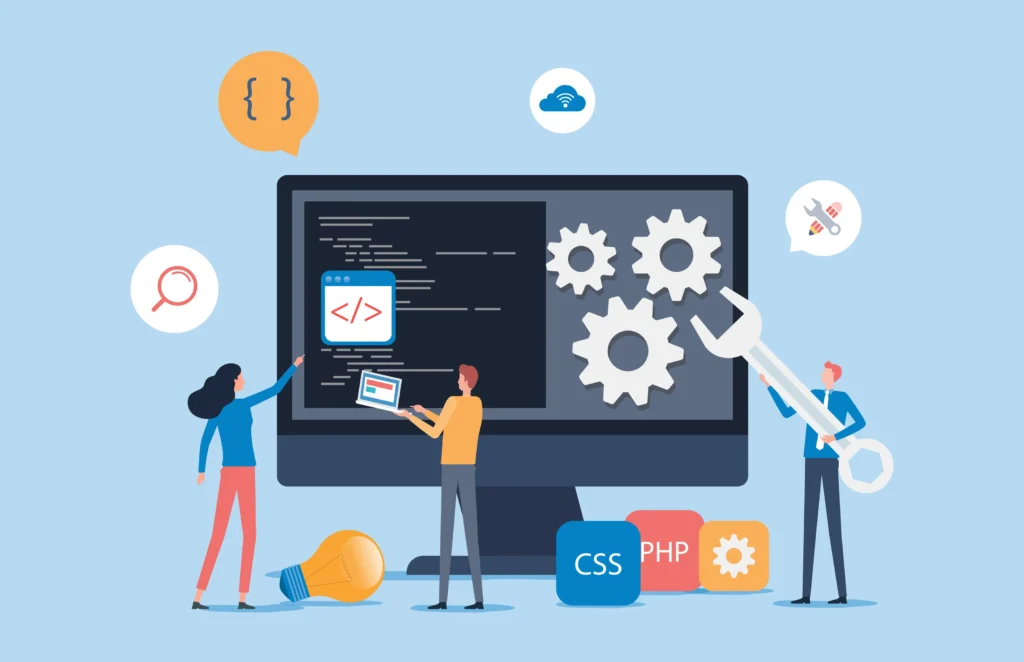Back-end development is the process of creating the foundation and functionality of web applications. This includes database management, server-side scripting, and API integration to ensure the application runs smoothly. Web applications would lack the necessary foundation for robust functionality if back-end development was not completed. Back-end developers are responsible for managing databases, writing server-side scripts, and integrating APIs to create powerful web applications.
Building a stable and dependable application that can effectively handle challenging tasks requires an understanding of the foundations of back-end development.
So let’s get into the topic to learn more about it.
What Is Back End Development?
Back-end development, also known as server-side development, is the process of creating and managing the behind-the-scenes functionality of a website or application.
This involves working on server-side software, which includes databases, back-end logic, application programming interfaces (APIs), architecture, and servers. Back-end developers write code that enables browsers to communicate with databases and manage data.
In addition to server-side software, back-end developers are also responsible for data processing. They build and maintain the mechanisms that process data and perform actions on websites. These developers ensure that these components communicate with each other smoothly and responsively.
Another important aspect of back-end development is maintaining security and performance. Back-end developers are responsible for data storage, security, and other server-side functions that are not visible to users. They also ensure that the website responds correctly and quickly to front-end user requests.
Back-end developers frequently work in teams, collaborating with front-end developers, product managers, principal architects, and website testers to create the structure of a website or mobile application. They must be familiar with a wide range of tools and frameworks, including languages like Python, Java, and Ruby.
Before we get into the details of backend development, you should be aware that security is an important consideration. Learn more about that in our article, “Backend Security: What It Is and Steps Protect your Sensitive Data“, to make sure that your back-end systems are secure.
Types of Backend Development Programming Languages
Backend development programming languages come in a variety of styles and flavours. It differs in terms of file size, performance, compatibility, required lines of code, and programming style. Some are object-oriented programming languages, whereas others can be compiled rather than interpreted.
So, what are the different types of backend development programming languages? Some of the most popular languages used in backend development were neatly explained in detail on the Upwork blog. These languages are:
- C++: This programming language combines all of the features of C with object-oriented programming concepts like classes. As a low-level programming language, it is used to communicate efficiently with system hardware, resulting in improved performance. This makes it ideal for video games, large web applications, and other use cases that require high system-level performance.
- C#: For Windows servers and environments, C# will be your first choice. If your technology stack is based on Microsoft products like ASP.NET, it’s likely that C# will be the most productive choice for your developers.
- Java: The object-oriented programming language Java is used for a variety of purposes. It is possible to run Java programmes on any computer by installing the Java Virtual Machine (JVM).
- JavaScript (Node.js): With the release of Node.js, the world saw that this all-purpose, object-oriented programming language was not limited to front-end scripting; it could also be utilised on the server-side of applications. JavaScript is becoming a popular option for front-end and back-end web development since it is one of the fundamental web technologies.
- PHP: The most widely used back-end programming language on the internet. PHP has a low learning curve, a large codebase, and a long history of support from the open-source developer community, making it a popular choice for back-end website development. PHP was in charge of running the back end of your WordPress-powered personal website, if you’ve ever done so.
- Python: A powerful data processing library can be found in Python, a general-purpose programming language. Python’s short code length and straightforward syntax are advantages for back-end developers looking to increase productivity.
- Perl: Popular in the Linux and Unix worlds, Perl is a general-purpose programming language created by Larry Wall in the 1990s. Log management and text manipulation are two of Perl’s strong points. It works well for quickly writing brief automation scripts.
- Scala: A general-purpose programming language that supports both functional and object-oriented paradigms. Scala, which is based on Java, is still powered by the JVM and compatible with Java.
- Ruby: A dynamically-typed general-purpose programming language, was created by Yukihiro “Matz” Matsumoto in the mid-1990s. Ruby is renowned for its ability to increase programmer productivity. It is known for its ability to integrate metaprogramming—code that can change while an application is running—into apps and supports procedural, functional, and object-oriented programming paradigms.

Tools & Technology
Many tools and technologies are used in back end development to manage databases, streamline the development process, and guarantee the security and functionality of web applications. Key instruments and technologies consist of:
- Programming Languages: Backend developers use several programming languages. Two of the most popular are PHP and Python.
- Database Management Systems: Backend developers work with databases to store, retrieve, and manipulate data. They use database management systems like MySQL, PostgreSQL, MongoDB, and others.
- Frameworks: Back end frameworks such as Django (Python), Express.js (Node.js), Ruby on Rails, and Spring (Java) provide structured environments for building robust back end systems.
- API Development Tools: Tools like Postman and Swagger simplify the process of designing, testing, and documenting APIs.
- Version Control Systems: Version control systems like Git enable collaborative development and efficient management of code repositories.
- Web Servers: Web servers like Apache, Nginx, and others are used to host websites and web applications.
- Testing & Deployment Tools: Tools like Jenkins, Docker, and Kubernetes are used for continuous integration, testing, and deployment of applications.
These tools help streamline the development process and ensure the reliability and scalability of back end systems. Additionally, they play a crucial role in maintaining the security and performance of web applications.
Front-end vs. Back-end Development: Difference
Front-end development is the aspect of web development that involves creating the user-facing part of a website or application.
This includes the design of the website’s layout, colors, and fonts. Front-end developers use languages such as HTML, CSS, and JavaScript to create the design and functionality of a website. Their goal is to ensure that users can easily interact with and navigate the site. They work directly with clients to create visual and interactive elements that form an aesthetically pleasing user experience.
On the other hand, back-end development deals with the server-side of a website or application.
Back-end developers work on parts of a website that users cannot see. They ensure that servers and databases function smoothly and quickly. They use programming languages like PHP and Python, and they work with databases to store, retrieve, and manipulate data. Back-end developers also ensure that the website responds correctly and promptly to front-end user requests.
While front-end development is about making sites and web applications render on the client-side, back-end development is all about making these apps render server-side. Back-end development is like the engine of a website—it’s all about making sure everything behind the scenes runs smoothly.
This is all you need to know about backend development. In the backend development process, there is a concept known as microservices, which is considered the key to agile and scalable systems. Our article, “Backend Microservices Architecture: Key to Agile, Scalable, and Resilient Systems“, explains the concept in greater detail.
Conclusion
To sum up, the development of secure, scalable, and reliable web applications depends heavily on back end programming. Back end developers build the framework for the smooth operation of web platforms by concentrating on server-side logic, databases, and APIs. To create high-performance web applications and provide the best possible user experiences, it is critical to understand the various programming languages, tools, and technologies associated with back end development.
Are you looking for an all-in-one website development solution that is both secure and optimised?
You should check out Nexa Lab’s web app development services.
We provide the best web app development services that ensure your scalability and performance, with comprehensive testing and quality assurance, with security and compliance in mind, as well as provide you with maintenance and support. Our solutions are customisable for businesses of all sizes, including small businesses.




